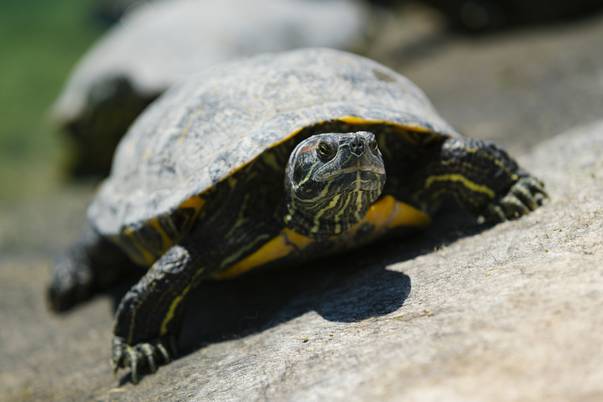Wade Vandervort
Red-eared turtles sunbathe at Craig Ranch Regional Park in north Las Vegas, Thursday April 22, 2021.
Thursday, May 27, 2021 | 2 a.m
The turtles are easy to spot in the ponds of Craig Ranch Regional Park in north Las Vegas.
On those warm late spring days, enough convex clams protrude from the water to make the ponds look like a colossal bowl of sentient muesli puffs.
How many turtles – mostly red-eared sliders, after a quick visual inspection – slide around and bask in one of the valley’s largest parks is unclear, but attentive patrons might think that there is more than usual for even this proliferative species.
Cass Palmer, director of the park system in north Las Vegas, said his department monitors urban wildlife in the city’s parks, but neither the parks nor the animal control departments actively survey or manage the resident animals. Neither does the Nevada Department of Wildlife, said an agency spokeswoman, because the turtles are pets – displaced pets or their offspring.
Turtles should or should not be in North Las Vegas by nature. Red-eared valves, in particular, are native to the humid subtropics of the southeastern United States, where they live in warm, calm waters. The approximately 750,000 gallon water features at Craig Ranch, which also attract herds of Canada geese and mallards, are man-made irrigation ponds, but these are good enough for the resilient, keratin-hard turtle.
“We don’t have the pond in stock,” said Palmer. “They are all either native (born) and find their way there – or mostly people let their pets free in the pond.”
Red-eared snipers are the most widely trafficked turtles in the world, with their watchful expressions, distinctive markings, and long necks and cocked heads that cut a classic profile.
But even when released by their zookeepers, the animals clearly thrive, said Nevada State College biology professor Kayla Bieser, a field herpetologist who has done extensive research on red-eared sliders.
Red-eared sliders are robust, opportunistic omnivores and have few natural predators here. Women lay up to 20 eggs at a time three to four times per season. (Raccoons can dig up nests, but raccoons are uncommon in the Las Vegas Valley.) And they don’t require a pristine environment – a hallmark of an invasive species, as red-eared sliders are being considered in Nevada and around the world.
Bottom line: lots of turtles in the desert. A whole lot.

Red-eared turtles sunbathe at Craig Ranch Regional Park in north Las Vegas, Thursday April 22, 2021.
“I was surprised too,” said Bieser, whose doctoral thesis focused on environmental influences on sexing in turtles. “And then I thought there was water, there was food, there was warmth. That’s all these people need. “
Turtles eat algae and other plant matter, as well as insects and larvae, and anything that humans bring for ducks and geese, although they shouldn’t. And since they are not a single animal, a large cohort will suit them well. Bieser said she wasn’t aware of a situation where there were too many red-eared sliders for a population to thrive.
A conscientious pet owner will keep them in a large tank with a UV heat lamp and basking stones and keep up with their varied diet and copious excrement. A large specimen can be up to 10 inches long and weigh 7 pounds, and they can live in captivity for 20 years or more.
A turtle owner who cannot make the commitment can simply let go of the animal in a park pond.
The Department of Wildlife lists red-eared gate valves (scientific name Trachemys scripta elegans) in its Nevada Aquatic Invasive Species Management Plan as a species that is more of a problem but offers possible control options and limited geographic distribution. Rather, the concern may be how the red-eared sliders might compete with a native species of Nevadas, the western pond turtle, found in the natural waterways of the Reno / Carson City area. Worst-case scenario, they’re a nuisance in southern Nevada and people may not rate them that way, Bieser said.
If food is scarce or disease develops, it could regulate the population. People can introduce them but may not just be able to take them out.
“Ultimately, most of these mitigation measures weren’t really successful anyway, unless you prevent the source from being entered, such as keeping people releasing turtles,” Bieser said. “It’s just about the turtles basically creating their own carrying capacity.”











